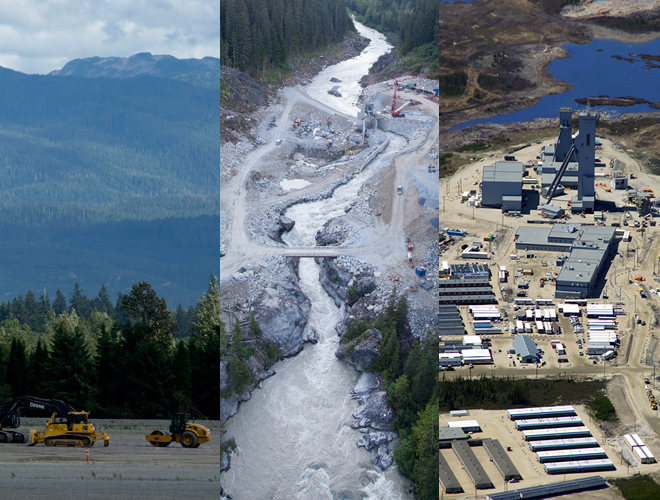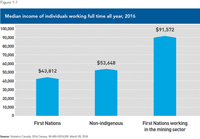The First Entrepreneurs – Natural Resource Development and First Nations

The media often convey the impression that First Nations wish to earn a living from traditional activities alone and have little interest in the development of their communities. Yet while some oppose mining and forestry or the building of energy infrastructure, others favour such development and wish to take advantage of the resulting wealth and jobs. This paper focuses on cases where First Nations decided to become involved in the development of resources on their territory, and on the benefits they derived from this involvement.
Media release: First Nations get richer thanks to oil, mining, and forests
 Related Content
Related Content
 |
 |
 |
| Les premiers entrepreneurs (La Presse+, November 9, 2018)
First Nations were the ‘first entrepreneurs’ (Edmonton Journal, November 13, 2018) |
Interview (in French) with Germain Belzile (Des matins en or, Ici Radio-Canada, November 12, 2018)
Interview (in French) with Germain Belzile (Boulevard du Pacifique, Ici Radio-Canada, November 13, 2018) |
Research Paper prepared by Germain Belzile, Senior Associate Researcher at the MEI, with the collaboration of Alexandre Moreau, Public Policy Analyst at the MEI.
Highlights
The media often convey the impression that First Nations wish to earn a living from traditional activities alone and have little interest in the development of their communities. Yet while some oppose mining and forestry or the building of energy infrastructure, others favour such development and wish to take advantage of the resulting wealth and jobs. This paper focuses on cases where First Nations decided to become involved in the development of resources on their territory, and on the benefits they derived from this involvement.
Chapter 1 – Natural Resources as an Economic Lever
- In Canada, First Nations located far from big cities are often situated in regions rich in natural resources with great potential for economic development, whether in forestry, mining, hydroelectric power, or fisheries.
- While there is no consensus among First Nations regarding natural resource development, according to some estimates, they took in $321 million of revenues from these resources in 2015-2016.
- Hydroelectric dams are often located on or near indigenous lands, so the support of affected First Nations is important to most hydroelectric power producers.
- The Tahltan Nation, wishing to be involved in and benefit from their territory’s development, created the Tahltan Nation Development Corporation in 1985, which its president described in 2015 as “a quintessential success story.”
- In Canada, 80% of indigenous communities live in wooded areas. It is therefore hardly surprising to see them involved in forestry, especially given the relatively high wages in that industry.
- The National Aboriginal Forestry Association estimates that from 1,200 to 1,400 indigenous companies are active in the forestry industry.
- Logging revenues for the Lax Kw’alaams Nation exceed $22 million a year, representing more than one-third of its total revenues and far exceeding federal government transfers.
- For many small coastal communities in Canada, aquaculture production is a major source of income as well as an industry that pays good wages, given income levels in remote areas.
- Aquaculture Canada has identified some fifty indigenous groups that are active in this sector, including the Kitasoo/Xai’Xais in British Columbia and the Waycobah in Cape Breton, Nova Scotia.
- Mining is one of the areas where First Nations are the most active, with 455 agreements signed in this sector between 2000 and 2017, often featuring priority hiring and subcontracting clauses for their members.
- In 2016, First Nations members working in the mining sector declared a median income twice as high as that of workers in their communities overall, and nearly twice as high as that of non-indigenous people as a whole.
Chapter 2 – Oil and Gas: Major Benefits and Missed Opportunities
- Canada is among the top five countries both for the production and for the export of oil and natural gas, supporting hundreds of thousands of direct and indirect jobs across the country.
- In terms of economic activity, crude oil and natural gas extraction represented $113 billion in 2017, or 6.5% of the country’s GDP, to which must be added nearly $20 billion in indirect economic activity.
- In the 2016-2017 fiscal year, natural gas was produced on 51 reserves belonging to 39 First Nations and oil was extracted on 35 reserves belonging to 25 First Nations.
- Crude oil and natural gas extraction directly employed slightly over 2,000 First Nations workers across the country in 2015, along with about 4,000 workers involved in support activities.
- While First Nations members holding jobs earned an average of $51,500 in 2016, before taxes, average wages were nearly $150,000 for those working in oil and gas extraction, and more than $200,000 for those working on gas pipelines.
- The Fort McKay Nation, with just under 900 members, has reported annual revenues of $60 million in recent years, reaching a peak of $80 million in the 2017-2018 fiscal year.
- The major partnership negotiated as part of Northern Gateway could have been another inspiring example of indigenous involvement in an oil project. But in November 2016, the federal government put an end to the project by choosing not to continue consultations.
- The Trans Mountain expansion project’s future is uncertain due to a ruling by the Federal Court of Appeal, which found that the National Energy Board’s assessment was flawed and that Ottawa had not adequately consulted the indigenous population before granting its approval.
- The uncertainty surrounding the regulatory process and its politicization have led to a number of oil or gas projects being terminated over the past few years, the value of which exceeds $100 billion since 2015.
- One study has estimated that, in 2018 alone, insufficient Canadian pipeline capacity will deprive companies in the energy sector of nearly $16 billion in income, due to lack of access to international markets.
Introduction – A Brief Picture
From a social standpoint, First Nations members face significant challenges, including rapid demographic growth and a higher prevalence of alcoholism, drug dependence, and family violence than among other segments of the population. Their life expectancy at birth is from three to fifteen years lower than that of other Canadians.(1) They also have inferior access to health care(2) and are well behind the rest of the Canadian population in terms of education.
Unemployment in these communities is more than double that of the non-indigenous population. Their median after-tax income is 30% lower than that of other Canadians. In addition, the proportion of low-income individuals is twice as high among First Nations.(3)
Inevitably, financial dependence on governments is significant. In 2012-2013, one-third of the First Nations population living on reserves drew benefits under the federal income assistance program, whereas only 5% of the Canadian population receives similar government benefits.(4)
Clearly, the situation of First Nations citizens can and must be improved.
What Is to Be Done?
Government assistance is not a sustainable way to get out of poverty. Access to high-quality jobs is what needs to be encouraged so that First Nations can play a greater role in the economy of their communities and of the country as a whole.
Natural resources are often found in abundance on First Nations territory. Further developing them would promote wealth creation and help alleviate the problems of poverty.
Whether we are looking at hydroelectric, mining, forestry, or oil and gas development, the areas surrounding indigenous communities offer significant economic opportunities, especially in terms of jobs.(5) Many First Nations have or claim ancestral title to the territories where such resources are located. The legal implications of this title offer First Nations the possibility of signing agreements with companies and governments in order to benefit from these resources.
But are such agreements feasible, and do First Nations members want this development of resources on the lands they claim?
Another First Nations Vision
The media often convey the impression that First Nations, and indigenous people in general, differ profoundly from other Canadians. The implication is that they wish to earn a living from traditional activities alone and have little interest in the development of their communities. Yet this is just a caricature of the reality.
While some First Nations oppose mining and forestry or the building of energy infrastructure, others favour such development and wish to take advantage of the resulting wealth and jobs. This cleavage is no different from what is found in non-indigenous cities and villages in Canada, where there is no vision for the future that everyone agrees upon.
There are indeed many examples of indigenous communities that have made a significant shift in favour of economic development, with everything that comes along with it: jobs, income, lower economic dependence, and much more. The distance of many First Nations from major urban centres, the often low educational level of many of their members, and the abundant resources on their territories have led many of them to regard resource exploitation as an engine for their development.
The Purpose of Our Research
This research paper does not aim to present the pros and cons of natural resource development, whether by or in collaboration with First Nations. The “cons” are often in the news. Our research has focused instead on tangible cases where First Nations decided to become involved in the development of resources on their territory, and on the benefits they derived from such involvement. This study, although not comprehensive, helps to show the impact that such projects have already had, and how they have the potential to profoundly alter the relationships between First Nations, companies, and non-indigenous people—how, above all, they provide a glimpse of a better future for indigenous people in Canada.
It does all this by giving a voice to indigenous players involved in these profound changes, which are undoubtedly just beginning. Six First Nations leaders involved in development projects agreed to be interviewed for this paper. Excerpts from these discussions are sprinkled throughout the text. One of the interviews is presented in full as an annex.
The impression one gets from this research is far from the pessimistic, even despondent, vision often associated with First Nations communities. It features indigenous leaders who are attached to their traditions but also turned resolutely to the future, people who are determined to preserve their environment but also intent to not depend on government largesse any longer, and who want to put food on the family table and to see their children benefit from better opportunities.
This is hardly surprising considering that the First Nations were the “first entrepreneurs” of this land, as one of their representatives recalls in these pages. In sum, this publication presents a part of the First Nations picture that is often so hidden that most people do not even suspect its existence.
Notes
1. Statistics Canada, Life expectancy, Chart 13: Projected life expectancy at birth by sex, by Aboriginal identity, 2017, November 30, 2015.
2. Social Determinants of Health, Access to Health Services as a Social Determinant of First Nations, Inuit and Métis Health, 2011, p. 1.
3. Statistics Canada, 2016 Census, Tables 98-400-X2016287, 98-400-X2016171, and 98-400-X2016173, 2016.
4. First Nations members living on-reserve receive benefits from the federal government, whereas those living off-reserve receive benefits from their respective province. Indigenous and Northern Affairs Canada, On-reserve Income Assistance Program, Income Assistance: Key facts, November 7, 2014.
5. Douglas Eyford, Forging Partnerships, Building Relationships, November 29, 2013, p. 23.
 The graphs (Click to enlarge)
The graphs (Click to enlarge)
 |
 |
 |

